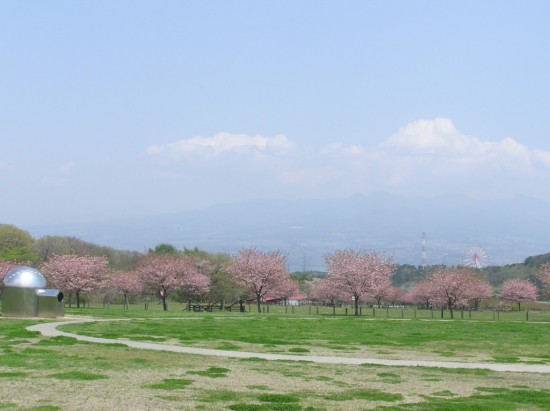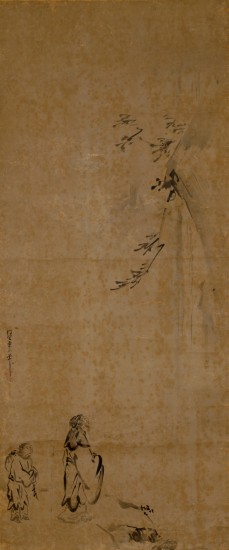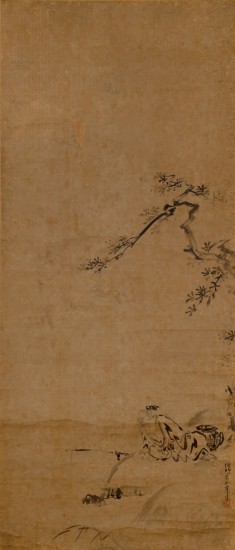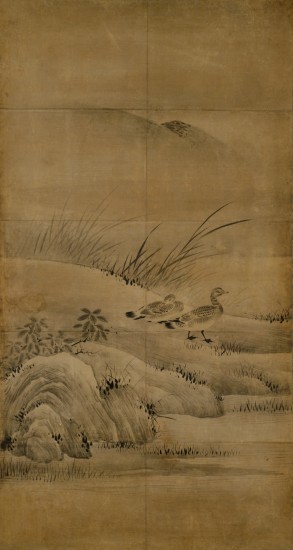In full blossom this Golden Week at Hara Museum ARC will be the yaezakura cherry blossoms, following the previously glory of the somei-yoshino cherry trees. At Ikaho Green Bokujo, the recreational ranch next to the museum, paths lined with the yaezakura sakura will be resplendent with glorious blossoms.

This is a view of a cherry-lined path from the corridor at Hara Museum ARC that leads to the Kankai Pavilion. The pink yaezakura blossoms are set off by the fresh green environs.
After enjoying blossoms, you can enjoy art. From April 29, Part II of the “Selections from the Hara Rokuro Collection” begins. A number of superb ink paintings have been chosen to replace the works that appeared in Part I.

Kano Tan’yu, Li Bai viewing waterfall (from Set of twelve hanging scrolls by painters of the Kano school), hand scroll, Edo period, 17th century

Kano Tan’yu, Taigongwang fishing at the shore (from Set of twelve hanging scrolls by painters of the Kano school), hand scroll, Edo period, 17th century
This painting is from Set of twelve hanging scrolls by painters of the Kano school, which is thought to have originally comprised a six-fold folding screen with depictions of Chinese historical figures. Among these artist is Kano Tan’yu (1602-74), who was responsible for two of the works, Li Bai viewing waterfall and Taigongwang fishing at the shore. The son of Kano Takanobu (1571-1618), we see traces of his artistic lineage in the mix of delicate and powerful lines that express the poet’s robes. These works are thought to have been painted by Tan’ yu while in his teens.
In this painting, the Tang-dynasty poet Li Bai (701-762) is writing a poem inspired by a waterfall in Lushan. This is an old theme that is based on Li Bai’s poem View of a Waterfall at Lushan, which is composed of four lines of seven characters each (shichigon zekku).
The fisherman in this painting is Taigongwang (Lu Shang), a military strategist during the Zhou dynasty in China. In the 11th century BC, Taigongwang served under the founder of the Zhou dynasty Emperor Wen Wang and his son Wu Wang, helping to defeat the state of Yin. In one legend, it is said Taigongwang was fishing when he was discovered by Wen Wang. The nickname Taigongwang, which literally means “Grand-Duke’s-Desire,” is said to have come from Wen Wang’s statement “You are the one that my grandfather, the Grand Duke, was looking for.”

Kano school, Birds and flowers [Paintings used for wallpaper and fusuma (Japanese sliding door) at Nikko-in Mi’idera Temple], four hanging scrolls, Momoyama – Edo Period , 16th-17th century
The Kano school paintings of birds and flowers are a continuation of a tradition that dates from medieval times. This painting was once one of the partition paintings (shohekiga) that decorated the Nikko-in guest hall at Mi’idera (Onjoji) Temple in Shiga prefecture, now remounted as hanging scrolls. Hara Rokuro acquired the Nikko-in guest hall and moved it to his estate in Gotenyama (present-day Kitashinagawa in Shinagawa ward, Tokyo) in 1892.
This painting shows a scene at the water’s edge where geese are at play, wagtails rest on rocks, and turtle doves sit on the branch of a large pine tree. The scene is depicted with a soft touch. Water fowl are symbolic of prosperity and happiness, while turtle doves symbolize marital harmony and plentiful offspring. It is a painting that one can enjoy as art and a wish for good fortune.
The space within the Kankai Pavilion provides a contrast with the colorful cherry blossoms. Here, color tone is dominated by black. In the East, the color of ink is said to serve five colors. Instead of black, I used “color of ink,” which is not the fifth color but the color that is impressive to the extent that it equals to five colors.
We hope you can make it to Hara Museum ARC this Golden Week and enjoy the beautiful blossoms!
———————————-
HARA MUSEUM ARC SPRING EXHIBITIONS
◆Kankai Pavilion (traditional East Asian art)
Selections from the Hara Rokuro Collection
Part I: March 26 (Sat.) – April 27 (Wed.)
Part II: April 29 (Fri./ National Holiday) – June 1 (Wed.)
◆Contemporary Art Galleries A, B and C
Cosmos: Selections from the Hara Museum Collection
Dates: March 26 (Sat.) – June 26 (Sun.)
Closed: Thursday (open on May 5)
* Subject to temporary closing in the event of severe weather.
Opening Hours
*Please click http://www.haramuseum.or.jp (website)
http://mobile.haramuseum.or.jp (mobile site)
———————————-
ACCESS
◇By Train◇
By JR Joetsu・Nagano Shinkansen
Recommended timetable
・10:12 Depart Tokyo Station→11:01 Arrive at Takasaki Station/ 11:11Depart Takasaki Satation→11:35 Arrive at Shibukawa Station
・11:12 Depart Tokyo Station→12:03 Arrive at Takasaki Station/ 12:20 Depart Takasaki Satation→12:44 Arrive at Shibukawa Station
・12:24 Depart Tokyo Station→13:14 Arrive at Takasaki Station/ 13:31 Depart Takasaki Satation→13:56 Arrive at Shibukawa Station
By JR Joetsu Limited Express Kusatsu
・9:00 Depart Ueno Station→10:37 Arrive at Shibukawa Station (No.31 ; operates only on Saturdays, Sundays and holidays)
・10:00 Depart Ueno Station→11:43 Arrive at Shibukawa Station (No.3 ; during April, operates only on Saturdays, Sundays and holidays))
・12:00 Depart Ueno Station→13:45 Arrive at Shibukawa Station (No. 5 ; during April, operates only on Saturdays, Sundays and holidays)
From Shibukawa Station, take the Kan-etsu Kotsu Bus and get off at the station “Green Bokujo Mae.” http://www.kan-etsu.net/r-bus/timetable/shibu-ikaho-1.htm (in Japanese only). ARC is about 7 minute walk from the bus station.
◇By Car◇
Take the Kan-etsu Expressway to Shibukawa Ikaho Interchange. Go in the direction of Ikaho Onsen for 8 km (about 15 min.) .
Highway information:
E-NEXCO Drive Plaza http://www.driveplaza.com/ (in Japanese only)
